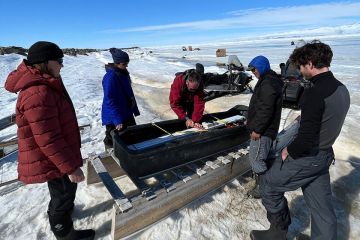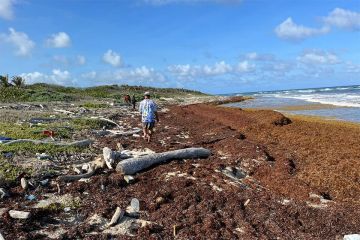Backgrounder: ONC’s neutrino observatory site assessment project
The neutrino site assessment project will deploy two specialized instrument arrays that will collect detailed measurements at ONC’s deepest node on its offshore observatory—Cascadia Basin, an abyssal plain 2,700 metres below sea level—to test the location’s potential for a future large-scale neutrino observatory.
Neutrinos are one of the universe’s most essential ingredients and one of nature’s most abundant subatomic particles, produced by nuclear reactions from solar fusion, radioactive decay and exploding stars. Travelling through normal matter—including the centre of the Earth and human bodies—at nearly the speed of light, non-interacting “ghost particle” neutrinos have no electrical charge, making them difficult to study. Detection requires large and very sensitive instruments.
In partnership with the Technical University of Munich and the University of Alberta, ONC installed two 120-metre-long instrument moorings, or “strings,” located 50 metres apart on June 24 from the Canadian Coast Guard ship Tully during the first leg of ONC’s Expedition 2018: Wiring the Abyss.
Between the two moorings, three photon-emitting and five photon-detecting optical modules will assess the transparency and darkness of seawater at Cascadia Basin over a two-year period. These photomultipliers produce and receive short-lived bursts of light that simulate the detection of neutrino interactions with other particles in the water column.
“The Cascadia Basin site provides access to a vast, mostly flat area with potential for infrastructure expansion that would be unhindered by natural obstacles or existing equipment,” says Benoit Pirenne, ONC’s executive director of user engagement. “The site also has the right water depth and is only moderately affected by bottom currents.”
ONC is scheduled to return to the project site on July 23-24 as part of the instruments’ commissioning phase. Once completed, data from the sensors will be available for free online in real-time via ONC’s Oceans 2.0 data management and archiving system.
ONC’s existing observatory infrastructure at Cascadia Basin, together with know-how, reliability and experience in deploying and maintaining deep-sea sensors, could help scientists better understand neutrinos and address some of the fundamental questions in astrophysics—such as those posed about the Big Bang and supernovae—and provide insight into the origin, evolution and fate of the universe.
“Neutrino detection is presently challenged by the complexity of deep-sea marine operations,” says Technical University of Munich physics professor Elisa Resconi, one of the project’s two principal investigators. “What makes ONC attractive for us is the combination of the organization’s expertise in deep-sea marine operations and the already-instrumented Cascadia Basin site—deep, dark and quiet—ideal conditions for a neutrino observatory.”
Other neutrino observatories are located around the globe—underwater in the ocean and deep lakes, underground in abandoned mines or tunnels beneath mountains, and encased in Antarctic ice—to isolate detection from cosmic rays and other background radiation. Neutrinos were originally hypothesized in the early 1930s, and first detected by experiment in the mid-1950s.
“The field of neutrino astronomy benefits significantly from having a detector network distributed around the globe, providing enhanced sensitivity and correlated measurements,” says University of Alberta associate physics professor Darren Grant, the project’s other principle investigator. “A deep-sea deployment in the Pacific does not yet currently exist, and a detector array at Cascadia Basin would complement the other large-scale arrays currently operating and in development.”
In this story
Keywords: research, physics, earthquake, oceans, ONC, marine, expedition, neutrino, Cascadia, observatory, science, bioluminescence
People: Benoit Pirenne




